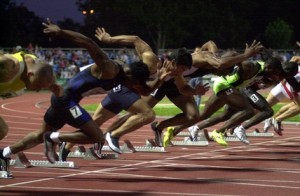Brian Schiff’s Blog
Injury Prevention, Sports Rehab & Performance Training Expert
Research has shown that strengthening the gluteus medius is clearly an essential way to reduce anterior knee pain and improve pelvic stability and function. The exercise I am sharing today is useful for improving hip strength and pelvic stability in a closed chain fashion.
In the video below, I demonstrate a very effective way to strengthen the gluteus medius and improve hip stability.
For a full description of the exercise, check out my latest column, Functionally Fit, by clicking here.
Seldom do I use my blog as a platform to rant, boast or anything in between. I generally like to share evidenced based information that helps improve your health and performance. But, every once in a while I feel the need to share my opinions on things I feel strongly about. Today, I want to offer you my suggestions and theory on professional excellence within the fields of health and fitness.

Let me preface this post by simply saying I would never think of writing this or publishing it online for the whole world to read without having several years (15 now) of professional experience under my belt and a proven track record of getting RESULTS for my clients. In my mind, the very reasons for my success include: being blessed with above average intelligence, a strong work ethic, a desire to help and serve others, unquenchable PASSION to be the very best I can be in my field, and an uncanny knack for seeing things others do not and using that information to make impactful exercise and treatment decisions for my patients and clients.
Where am I going with this? Well, unfortunately, not all trainers, coaches and physical therapists share this same passion or possess this knack that I speak of. Some are content after college (or certification) to be good enough and may not read literature, go above and beyond with continuing education, surround themselves with the best in the business or strive to be better each day. Others may simply not have an innate ability to problem solve and synthesize given data to construct the right plan for the client. Often trainers and clinicians default to what is easy or “what they know” as opposed to viewing each client in a different light. In other words, they lack artistry. They will never be revered like Picasso (pictured below).

Eliminating the “false step” has been a personal mission of many strength coaches I have heard or worked alongside of in my 15 year career. I used to wonder quietly why it was such a bad thing early on in my coaching. Based on angles and observation it seemed almost reflexive for most athletes.
Then a few years ago I had the privilege of seeing Lee Taft present his theory on speed development and multi-directional speed training and it all came together for me. Lee eloquently explained that the “false step” is really just a plyo step – a chance to load the body up for what it was meant to do. It essentially allows the athlete to reposition the body (or center of mass) more efficiently to load and explode. Ever wonder why sprinters use a starting block?

Look at all like an athlete’s body position once they step back and begin to move forward?
This topic has been covered in previous point/counterpoint articles in the NSCA journals and debated on forums, blogs and seminars alike. For me, I have been encouraging the “false step” or “plyo step” the past few years because it is ‘normal’ for athletes to move that way. As a matter of fact, one of the first things I do is put them in an athletic parallel stance position and ask them to accelerate for 10 yards. Not once have I seen them not step back provided I do not cue them to do so.
Keep in mind that previous research done (Kraan, GA, van Veen, J, Snijders, CJ, and Storm, J. Starting from standing: Why step backwards? J Biomech 34: 211–215, 2001.) indicates that stepping back is instinctive in up to 95% of subjects. Pretty telling, right? Even so, many coaches will still argue this technique slows the athletes down.
Through my clinical practice and sports performance training, I continue to focus on eliminating core and hip dysfunction. I think many of the knee problems I see in runners and females are related to weakness in the glutes and small lateral rotators. There has also been quite a buzz about a recent article written in the Strength & Conditioning Journal on crunches and whether spinal flexion may actually be good for you.
This topic alone could take up several posts so, I will not delve into that today. However, as one who has experienced sciatica and disc injury firsthand, I probably tend to fall a little more in the camp of focusing on a neutral spine and resisting external forces as I feel this helps improve performance and reduce injury risk. In that vain, I have been continuing to develop my own core and hip stability progressions with my advanced clients/athletes.
I have been doing a series of posts for BOSU and PFP in my Functionally Fit Column. In my last post, I covered a 3D mountian climber with hip extension. In today’s post, I am covering a great core exercise with the BOSU Ballast Ball focusing on hip extension with the goal of improving shoulder, core and hip stability while promoting hip extension and disassociation.
In the video below you can check out the progressions (incline and decline)
Click here to read the full article on technique and application. The article reviews a regression for those not ready to tackle this quite yet. I think you will find this exercise challenging and rewarding.
In my practice, I take care of many athletes ranging in age from 10 and up. Many of the injuries I see are related to over training and overuse. Common things I see in the clinic on a daily basis include but are not limited to:
- Tendonitis
- Shin splints
- IT Band Syndrome
- Patellofemoral pain
- AC joint pain/arthritis
The list can go on and on. There are many factors (inherent and training related) that contribute to such problems. I personally believe many problems can be prevented with better education, smarter training, coaching predicated on individuality and physical response, and of course adding in more recovery. Cross training is also a must – just look at what sport specialization at an early age has done to current injury rates.
You need not look any further than the declining age of patients walking through the door with what I term “repetitive microtrauma” injuries. I saw a 14 year old cross country female runner a few weeks ago who had her second stress reaction injury inside of 12 months. In addition, the rise in the number of Tommy John surgeries performed in the past decade with respect to those having them at an earlier age may serve as a harsh warning sign about doing too much too soon or doing too much of the same thing year round.
I say all this simply to say we must not be oblivious to the rise in these types of mechanical injuries. Throwing, swimming, and running are all activities that become dangerous if done in excess, and they also produce predictable injury patterns. So, if you are curious about some risk factors and how to better balance your training and manage these types of injuries, then check out a webinar I just did for Raleigh Orthopaedic Clinic last week (click on the screen shot below to view the webinar)
This presentation is ideal for athletes, parents, weekend warriors and sports coaches looking for practical, straightforward information on this topic with some foundational guidelines that can be applied objectively and immediately to injury management and recovery. If this information helps just one person avoid an injury or accelerate their recovery then I will be thrilled! Please feel free to forward this post to friends, share it on FB or tweet it!


